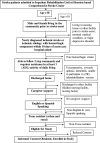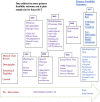Telemedicine-guided education on secondary stroke and fall prevention following inpatient rehabilitation for Texas patients with stroke and their caregivers: a feasibility pilot study
- PMID: 28871024
- PMCID: PMC5589055
- DOI: 10.1136/bmjopen-2017-017340
Telemedicine-guided education on secondary stroke and fall prevention following inpatient rehabilitation for Texas patients with stroke and their caregivers: a feasibility pilot study
Abstract
Introduction: The aftermath of stroke leaves many consequences including cognitive deficits and falls due to imbalance. Stroke survivors and families struggle to navigate the complex healthcare system with little assistance posthospital discharge, often leading to early hospital readmission and worse stroke outcomes. Telemedicine Guided Education on Secondary Stroke and Fall Prevention Following Inpatient Rehabilitation feasibility study examines whether stroke survivors and their caregivers find value in telerehabilitation (TR) home visits that provide individualised care and education by a multidisciplinary team after discharge from inpatient rehabilitation.
Methods and analysis: A prospective, single arm, pilot study is designed to evaluate the feasibility of weekly TR home visits initiated postdischarge from inpatient rehabilitation. Newly diagnosed patients with stroke are recruited from a Houston-based comprehensive stroke centre inpatient rehabilitation unit, loaned an iPad with data plan and trained to use information technology security-approved videoconferencing application. After hospital discharge, six weekly TR home visits are led by rotating specialists (pharmacist, physical/occupational therapist, speech therapist, rehabilitation physician, social worker, geriatrician specialised in fracture prevention) followed by satisfaction survey on week 7. Specialists visually assess patients in real time, educate them on secondary stroke and fall prevention and suggest ways to improve function including direct medical interventions when indicated. Primary outcomes are proportion of eligible patients consenting to the study, participation rate in all six TR home visits and satisfaction score. The study started 31 December 2015 with plan to enrol up to 50 patients over 24 months. Feasibility study results will inform us as to whether a randomised controlled trial is warranted to determine efficacy of TR home visit intervention in improving stroke outcomes.
Ethics and dissemination: Ethics approval obtained by the Institutional Review Board (IRB), Committee for the Protection of Human Subjects, IRB number: HSC-MS-14-0994. Study results will be submitted for publication in a peer-reviewed journal.
Keywords: neurology; rehabilitation medicine; stroke; telemedicine.
© Article author(s) (or their employer(s) unless otherwise stated in the text of the article) 2017. All rights reserved. No commercial use is permitted unless otherwise expressly granted.
Conflict of interest statement
Competing interests: None declared.
Figures



Similar articles
-
A randomized controlled trial on Stroke telerehabilitation: The effects on falls self-efficacy and satisfaction with care.J Telemed Telecare. 2015 Apr;21(3):139-43. doi: 10.1177/1357633X15571995. Epub 2015 Feb 12. J Telemed Telecare. 2015. PMID: 25680390 Free PMC article. Clinical Trial.
-
Effectiveness and cost-effectiveness of a virtual multidisciplinary stroke care clinic for community-dwelling stroke survivors and caregivers: a randomised controlled trial protocol.BMJ Open. 2019 May 10;9(5):e026500. doi: 10.1136/bmjopen-2018-026500. BMJ Open. 2019. PMID: 31079082 Free PMC article.
-
Rehabilitation using virtual gaming for Hospital and hOMe-Based training for the Upper limb post Stroke (RHOMBUS II): protocol of a feasibility randomised controlled trial.BMJ Open. 2022 Jun 7;12(6):e058905. doi: 10.1136/bmjopen-2021-058905. BMJ Open. 2022. PMID: 35672074 Free PMC article.
-
Telerehabilitation Following Stroke.Phys Med Rehabil Clin N Am. 2024 May;35(2):305-318. doi: 10.1016/j.pmr.2023.06.005. Epub 2023 Aug 12. Phys Med Rehabil Clin N Am. 2024. PMID: 38514220 Review.
-
Recent trends in telerehabilitation of stroke patients: A narrative review.NeuroRehabilitation. 2022;51(1):1-22. doi: 10.3233/NRE-210330. NeuroRehabilitation. 2022. PMID: 35527574 Review.
Cited by
-
e-Health solution for home patient telemonitoring in early post-acute TIA/Minor stroke during COVID-19 pandemic.Int J Med Inform. 2021 Aug;152:104442. doi: 10.1016/j.ijmedinf.2021.104442. Epub 2021 Mar 24. Int J Med Inform. 2021. PMID: 34058641 Free PMC article.
-
Teleneurorehabilitation program (virtual reality) for patients with balance disorders: descriptive study.BMC Sports Sci Med Rehabil. 2021 Aug 2;13(1):83. doi: 10.1186/s13102-021-00314-z. BMC Sports Sci Med Rehabil. 2021. PMID: 34340687 Free PMC article.
-
Implementation of home-based health promotion program to improve flow-mediated dilation among patients with subacute stroke.J Educ Health Promot. 2020 Feb 28;9:41. doi: 10.4103/jehp.jehp_583_19. eCollection 2020. J Educ Health Promot. 2020. PMID: 32318609 Free PMC article.
-
A Low-Cost System Using a Big-Data Deep-Learning Framework for Assessing Physical Telerehabilitation: A Proof-of-Concept.Healthcare (Basel). 2023 Feb 9;11(4):507. doi: 10.3390/healthcare11040507. Healthcare (Basel). 2023. PMID: 36833041 Free PMC article.
-
Knowledge, attitude, and practice regarding stroke potential complications among stroke survivors' family members in Shiraz, Iran.Turk J Phys Med Rehabil. 2022 Aug 10;69(1):83-88. doi: 10.5606/tftrd.2022.9512. eCollection 2023 Mar. Turk J Phys Med Rehabil. 2022. PMID: 37201008 Free PMC article.
References
MeSH terms
Grants and funding
LinkOut - more resources
Full Text Sources
Other Literature Sources
Medical
